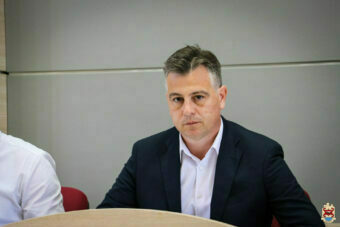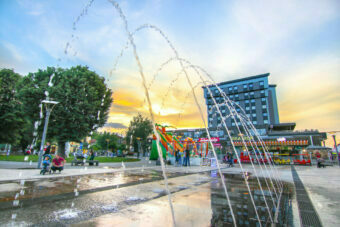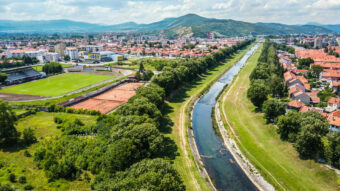
Pirot is a town in southeastern Serbia whose first historical records date back to the 3rd century and it was also once known as the Tures settlement during Ottoman rule. Pirot had to wait until 2016 to be given the formal status of a town. The town is known for its abundant cultural tradition and turbulent history. In the gourmand community, it became popular because of its flat sausage, which, together with its traditionally weaved carpets and cheese, represent Pirot’s Holy Trinity of tastes, smells and colour, to quote the locals. Although these are good reasons to present this particular city in this magazine issue, another good reason to feature this town in our magazine is the fact that Pirot made great strides in environmental protection and sustainable energy development in the last few years. We talked with Vladan Vasić, the long-term municipal president and the first mayor of Pirot, about ongoing projects, opportunities and plans for the future.
EP: The primary selection of waste is in its infancy in Serbia, with Pirot being one of the first cities where households will separate waste. What can you tell us about this project?
Vladan Vasić: The primary waste selection project involves the sorting of municipal waste at the point of origin. The Pirot district is one of the four regions in Serbia that is included in the project which stipulates the procurement of bins, containers and auto-garbage trucks and is financed by the IPA 2017 programme. The project envisages the distribution of 240-litre-blue-plastic-bins to all households in the city, to be used for the so-called dry fraction of waste which includes paper, cardboard, bags and PET packaging, the allocation of dry waste blue containers in residential blocks and yellow containers for depositing glass waste. The project is in the final implementation phase and so far, around 2,200 bins have been distributed in 63 streets. The allocation of containers in residential blocks will begin soon. I would like to add that a hall with a secondary waste separation line was built at the regional landfill. In early August, the first quantities of separated primary waste were collected from households which previously had been given appropriate bins. The first results are encouraging, as a certain quantity of clean material has been collected which can fetch a good price on the secondary raw material market.
IN FOCUS:
- SERBIA ON THE PATH OF GREEN TRANSITION
- HOW TO BECOME A PROSUMER?
- A BETTER LEGAL FRAMEWORK AND INCENTIVE MEASURES ARE A CONDITION FOR THE DEVELOPMENT OF THE RECYCLING INDUSTRY
EP: Air in Pirot was extremely polluted during the last heating season, and the media reported that the concentration of harmful particles was five times higher than allowed. What is the main source of air pollution in Pirot and how to eliminate its harmful effects?

Vladan Vasić: Since 2013, Pirot has been carrying out regular monitoring of SO2, soot, NO2, total sediments, lead, cadmium and zinc in air sediment. In the past three years, the data from the report show that the quantity of soot exceeded permitted values, especially in the winter months. On a monthly level, the values were excessive in the period between 5 and 10 days, and the causes of this are industrial plants that use coal and fuel oil, a substantial increase in the number of cars in the city, and people using solid heating fuel. An automatic air quality measurement station became operational in August 2021, which registers data in real-time that is monitored on the State Network for Automatic Monitoring of Air Quality website and it measures the concentration of PM10 and PM2.5 particles and SO2. People can see these measurements on their mobile phones and computers. The city invested significant funds in the construction of a new power plant that no longer uses fuel oil but compressed gas as an energy source. At the same time, all the boiler rooms in the apartment blocks were shut down. In cooperation with the Ministry of Energy and the Ministry of Environmental Protection, we carried out tenders for the procurement of biomass stoves for individual households. We also implemented a project that financed the installation of biomass boilers in four schools and one kindergarten that were not connected to the district heating system. The coal-fired boiler room in the town centre, which was located on the premises of the vocational high school and the Pedagogical Academy, was shut down.
EP: Renewable energy sources are one of the prerequisites for clean air, and given the line Ministry’s incentives, the new Renewable Energy Sources Law, and the increasing prices of fossil fuels, now is the right time for investments. Which type of RES has the greatest potential in Pirot?

Vladan Vasić: Thanks to its natural characteristics, the city of Pirot has great potential for the production of energy from renewable sources. Solar and biomass energy are areas that stand out for their potential and available opportunities. The city of Pirot has significant experience and implemented projects using biomass, such as the first PPP project in Serbia (heating in four schools). In recent years, projects have been launched to build several large-capacity solar power plants, both by domestic and foreign investors, with an installed capacity of around 100MW. Also, last year, the City of Pirot decided to procure and instal solar power plants that would work in the buyer-seller mode for certain facilities under the City’s authority. As a result, several design and construction projects are currently ongoing — a 27kW-power-plant on the premises of public enterprise Komunalac, a 150kW-power-plant at the secondary separation facility of PUK Regional Landfill and a 150-kW-power-plant at the pumping station facility of public enterprise Vodovod i Kanalizacija. Also, 15 kW and 5 kW power plants were installed on the roofs of the Economic and Technical School. Under the auspices of the Public Competition, launched by the Ministry of Mining and Energy, the plan is to co-finance citizens to install solar power plants in buyer-seller mode with a total power of about 90kW. The potential is great, we have set goals and many activities have been implemented that will pick up the pace even more in the coming period. Our vision is to develop the maximum capacities for the use of solar energy sustainably and for the city of Pirot to bear the epithet of the first sunny city in our country.
EP: The Energy Efficiency Fund was also established. What has been done so far in Pirot in that respect and what are your plans?
Vladan Vasić: The City of Pirot was one of the first local governments to form its Energy Efficiency Fund. The motive behind this is to co-finance energy efficiency measures which would benefit citizens, i.e. natural persons. Funds come from the city budget but also other sources such as donations or the Republic of Serbia’s budget. In the past five years, activities were carried out that included co-financing of up to 50 per cent of the value of projects, such as the drafting of energy efficiency studies for 14 residential buildings, the drafting of project documentation for energy rehabilitation for 16 residential buildings, the installation of heat energy consumption metres on the internal heating installation for 7 groups of customers/end users of district heating system, and works on thermal insulation of the fronts on 7 residential buildings. The total amount of allocated funds is about 38 million dinars. Also, in 2021 and cooperation with the Ministry of Mining and Energy, the City of Pirot’s Energy Efficiency Fund, launched a public competition after which we gave out grants to citizens to be used for energy rehabilitation of family houses in Pirot. As part of this competition, around 9 million dinars have been allocated for co-financing of energy rehabilitation measures. The subsidy budget for the 2022 competition will be 30 million dinars.
Prepared by: Milica Marković
Read the story in the new issue of the Energy portal Magazine Waste Management.



